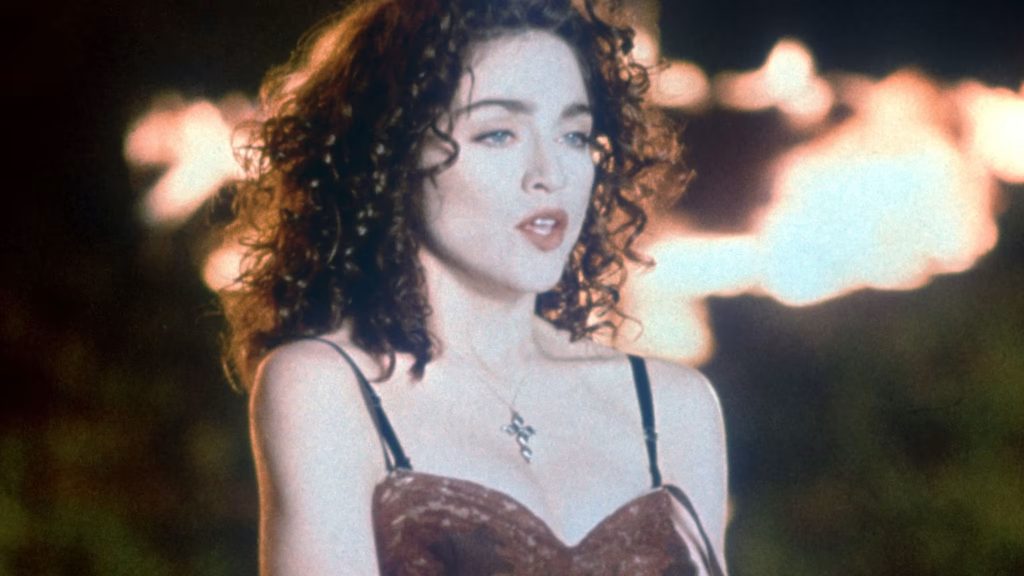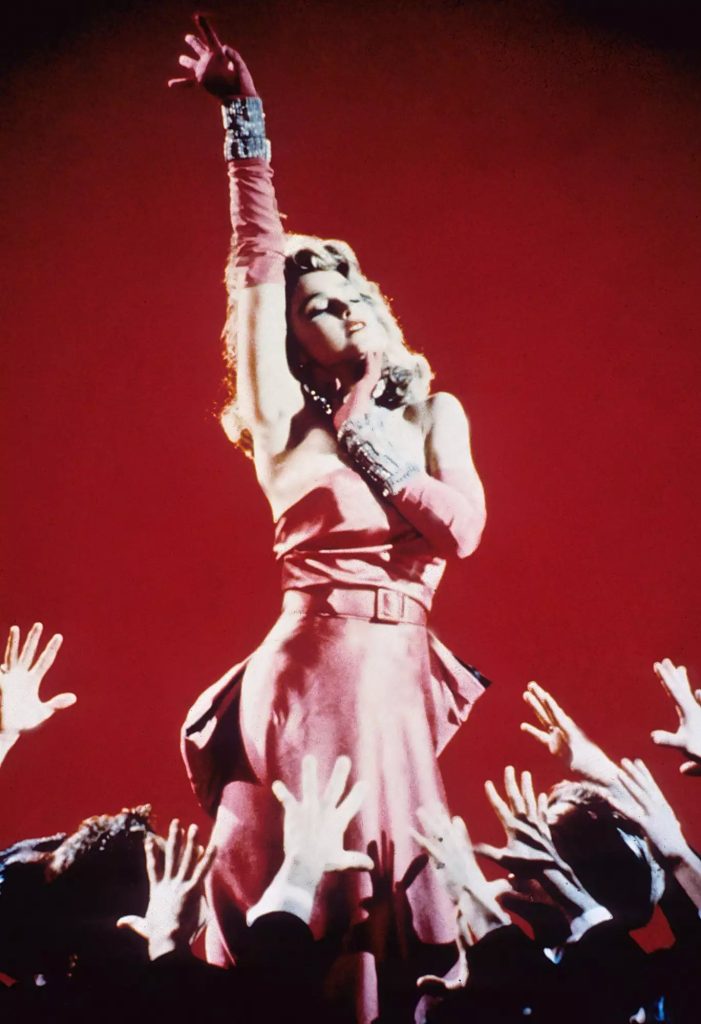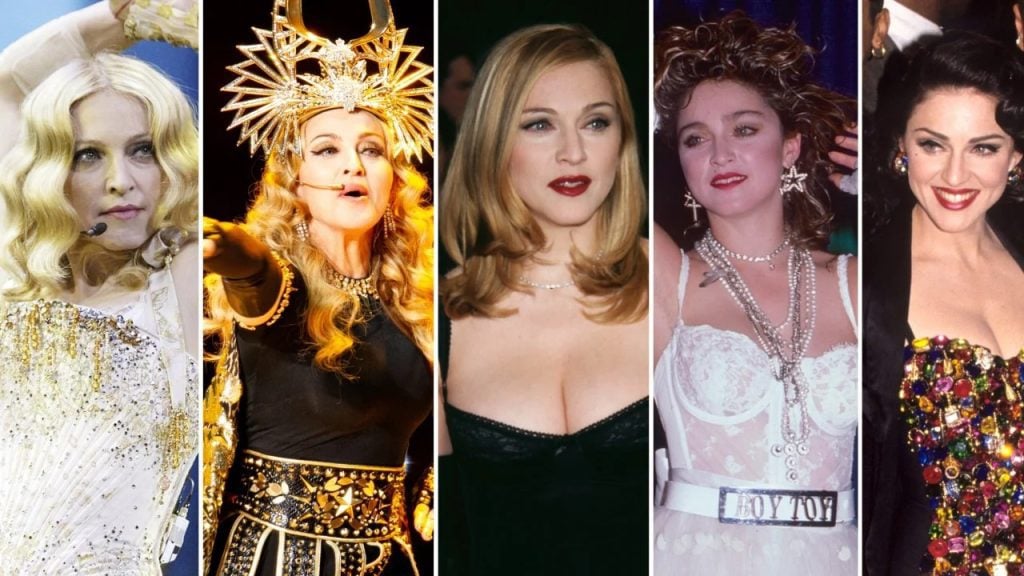Madonna‘s ascent in the 1980s wasn’t just the emergence of a new pop star; it was the birth of a cultural icon who would define a generation. With her debut in the early part of the decade, she captured the zeitgeist of an era that was all about bold expressions, innovative music, and breaking free from the constraints of the past. Her blend of catchy pop tunes with an underground club vibe, all delivered with an unmistakable flair, marked the arrival of an artist who was destined to leave an indelible mark on the music and fashion worlds.
Madonna’s early work was a mirror to the eclectic influences she absorbed while navigating New York’s vibrant music scene. From the punk-rock energy of CBGB to the discotheques of Studio 54, her music became a tapestry of the sounds and styles that defined New York in the late ’70s and early ’80s. Her debut album, with tracks like Holiday and Lucky Star, was a testament to this melange of influences, showcasing a sound that was as diverse as the city from which it emanated.
Madonna’s Musical Journey in the 80s
Madonna’s eponymous debut album “Madonna” wasn’t just a commercial success; it was a cultural phenomenon that introduced the world to a new kind of pop star. The album, with its infectious dance tracks and Madonna’s distinctive vocal style, resonated with audiences worldwide, setting the stage for what would be a decade of dominance in pop music. Songs like Borderline and Holiday became anthems of the era, blending post-disco beats with pop sensibilities in a way that was fresh and exhilarating.
With the release of the album Like a Virgin in 1984, Madonna didn’t just push the boundaries; she obliterated them. The title track, with its provocative lyrics and catchy melody, became a defining song of the decade, emblematic of the era’s spirit of liberation and self-expression. The album, produced by Nile Rodgers, was a masterclass in pop production, featuring tracks that ranged from the funk-laden Material Girl to the synth-driven Into the Groove, showcasing Madonna’s versatility as an artist.
Released in 1986 album True Blue marked a significant evolution in Madonna’s artistry, as she delved into more personal and complex themes. The album, dedicated to her then-husband Sean Penn, explored the intricacies of love, relationships, and identity, with tracks like Papa Don’t Preach addressing issues like teenage pregnancy with a nuance that was rare in pop music at the time. The album’s diverse musical palette, from the retro-inspired True Blue to the heart-wrenching Live to Tell, highlighted Madonna’s growth as a songwriter and musician.
The release of Like a Prayer in 1989 was a watershed moment in Madonna’s career, showcasing her at her most artistically ambitious and culturally provocative. The title track’s fusion of gospel and pop, coupled with a music video that tackled themes of race, religion, and sexuality, sparked widespread controversy but also critical acclaim. This period of Madonna’s career was marked by a boldness in both her musical choices and her engagement with social and cultural issues, cementing her status as an artist unafraid to use her platform to challenge and provoke.
The Wedding Dress Performance at the MTV VMAs
Madonna’s performance of Like a Virgin at the 1984 MTV Video Music Awards, where she appeared on stage in a wedding dress, was more than just a pop performance; it was a cultural moment that broke new ground in the intersection of music and fashion. This iconic performance, complete with a Boy Toy belt and lace gloves, challenged traditional notions of femininity and bridal purity, redefining what it meant to be a woman in pop music.
The Boy Toy Look
The Boy Toy look, characterized by layered accessories, mesh tops, and crucifix jewelry, became synonymous with Madonna in the 80s. This look, a blend of punk rebelliousness and playful femininity, was not just a fashion statement but a declaration of independence and self-expression. It inspired a generation of young women to embrace their sexuality and identity with confidence and defiance.
Religious and Cultural Symbolism in Attire
Madonna’s use of religious and cultural symbols, from the ubiquitous crucifixes to the incorporation of Middle Eastern motifs in her Like a Prayer video, was both groundbreaking and controversial. This blending of the sacred and the profane in her visual presentation sparked debates about cultural appropriation and the boundaries of artistic expression, highlighting Madonna’s role as a provocateur who used fashion as a means to challenge societal norms.

Photography by DAVID MCGOUGH
Courtesy of DMI / THE LIFE PICTURE COLLECTION

LIke a Prayer Music Video Still, 1989

Material Girl Music Video, 1985
Influence on 80s Pop Culture and Fashion
Madonna’s influence on 80s fashion was unparalleled. Her eclectic style, which mixed streetwear with high fashion, set trends that defined the decade. From the rubber bracelets and fishnet stockings to the iconic conical bras, Madonna’s fashion choices were as influential as her music, inspiring designers and fans alike to embrace a more daring and expressive approach to fashion.
Madonna’s impact on the 80s extended beyond music and fashion into the realm of social and cultural discourse. Her unabashed expression of female sexuality and her challenges to traditional gender roles made her a feminist icon of the era. Songs like Express Yourself and Papa Don’t Preach became anthems of female empowerment, while her public persona challenged the boundaries of what was considered acceptable for women in the public eye.
Madonna’s adept use of the music video format, particularly in the early days of MTV, transformed the landscape of pop music. Her visually stunning and narrative-driven videos, from the street dance vibes of “Into the Groove” to the controversial imagery of Like a Prayer, were not just promotional tools but artistic statements that complemented her music and expanded her influence into the realms of film and visual art.
Collaborations and Key Influencers
Madonna’s collaborations throughout the 80s played a significant role in shaping her musical evolution. From the dance-inflected production of Jellybean Benitez on her debut album to the groundbreaking work with Patrick Leonard and Stephen Bray on later albums, these collaborations brought out the best in Madonna’s music, allowing her to explore new sounds and styles.
The dance floors of the late 70s and early 80s, pulsating with the rhythms of disco, dance, and new wave, were a crucible for Madonna’s early sound. The infectious beats of disco and the edgy energy of new wave infused her music with a vitality that was irresistible, reflecting the eclectic tapestry of influences that she would continue to draw upon throughout her career.
Legacy of Madonna’s 80s Era
The legacy of Madonna’s 80s era is etched not just in the music history but also in the evolution of pop culture and fashion. Her fearless experimentation with music and style, her ability to tap into the cultural zeitgeist, and her unapologetic assertion of female power and sexuality have left an indelible mark on the industry, influencing countless artists and designers who have followed in her footsteps.
The revival of 80s aesthetics in contemporary pop culture, from the neon-lit synths of today’s music to the resurgence of vintage fashion trends, is often tinged with nostalgia for Madonna’s iconic style and sound. This enduring appeal speaks to the timeless quality of her work and the deep connection that her music and image have forged with audiences across generations.
The Enduring Appeal of Madonna’s 80s Hits
Madonna’s 80s hits, from the exuberant Holiday to the soulful Live to Tell, continue to resonate with audiences around the world. These songs, with their memorable melodies and evocative lyrics, stand as testaments to a time when pop music was in the throes of a vibrant evolution, and at the heart of that transformation was Madonna, the Material Girl who became the Queen of Pop.


